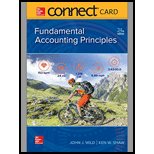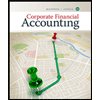
Connect Access Card For Fundamental Accounting Principles
24th Edition
ISBN: 9781260158526
Author: John J Wild
Publisher: McGraw-Hill Education
expand_more
expand_more
format_list_bulleted
Concept explainers
Textbook Question
Chapter 5, Problem 13QS
Exercise 5-13 Physical count error and profits A2
Refer to the information in Exercise 5-12 and indicate whether the failure to include in-transit inventory as part of the physical count results in an overstatement, understatement, or no effect on the following ratios.
a. Gross margin ratio
b. Profit margin ratio C. Acid-test ratio
d.
Expert Solution & Answer
Want to see the full answer?
Check out a sample textbook solution
Students have asked these similar questions
What is the total period costs for the month under variable costing
Need help
Need help this question solution
Chapter 5 Solutions
Connect Access Card For Fundamental Accounting Principles
Ch. 5 - Prob. 1DQCh. 5 - Prob. 2DQCh. 5 - Prob. 3DQCh. 5 - Prob. 4DQCh. 5 - 5. How does a company that uses a perpetual...Ch. 5 - Prob. 6DQCh. 5 - What is the difference between a sales discount...Ch. 5 - Prob. 8DQCh. 5 - Prob. 9DQCh. 5 - What is the difference between the single-step and...
Ch. 5 - Prob. 11DQCh. 5 - Prob. 12DQCh. 5 - Prob. 13DQCh. 5 - Refer to the income statement of Samsung in...Ch. 5 - Prob. 15DQCh. 5 - Applying merchandising terms C1 P1 Enter the...Ch. 5 - Identifying inventory costs C2 Costs of $5.000...Ch. 5 - Merchandise accounts and computations C2 Use the...Ch. 5 - Computing net invoice amounts P1 Compute the...Ch. 5 - Recording purchases, returns, and discounts taken...Ch. 5 - Recording purchases and discounts taken P1 Prepare...Ch. 5 - Recording purchases and discounts missed Pl...Ch. 5 - Recording sales, returns, and discounts taken P2...Ch. 5 - Accounting for shrinkage—perpetual system P3...Ch. 5 - Closing entries P3 Refer to QS 5-9 and prepare...Ch. 5 - Multiple-step income statement P4 For each item...Ch. 5 - Preparing a multiple-step income statement P4...Ch. 5 - Exercise 5-13 Physical count error and profits A2...Ch. 5 - Prob. 14QSCh. 5 - Prob. 15QSCh. 5 - Prob. 16QSCh. 5 - Recording purchases, returns, and...Ch. 5 - Recording sales. returns, and discounts—periodic &...Ch. 5 - Prob. 19QSCh. 5 - Prob. 20QSCh. 5 - Prob. 21QSCh. 5 - Prob. 22QSCh. 5 - QS 5-23 Sales transactions P2
Prepare journal...Ch. 5 - Exercise 5-1 Computing revenues, expenses, and...Ch. 5 - Prob. 2ECh. 5 - Exercise 5-3 Recording purchases, purchases...Ch. 5 - Exercise 5-4 Recording sales, sales returns, and...Ch. 5 - Exercise 5.5 Recording purchases, purchases...Ch. 5 - Exercise 5-6 Recording sales, purchases, and cash...Ch. 5 - Exercise 5-7 Recording sales, purchases, shipping,...Ch. 5 - Exercise 5-8 Inventory and cost of sales...Ch. 5 - Exercise 5-9 Recording purchases, sales, returns,...Ch. 5 - Exercise 5-10 Preparing adjusting and closing...Ch. 5 - Prob. 11ECh. 5 - Exercise 5-12 Impacts of inventory error on key...Ch. 5 - Exercise 5-13 Physical count error and profits...Ch. 5 - Prob. 14ECh. 5 - Prob. 15ECh. 5 - Prob. 16ECh. 5 - Prob. 18ECh. 5 - Prob. 19ECh. 5 - Prob. 20ECh. 5 - Prob. 21ECh. 5 - Prob. 22ECh. 5 - Prob. 23ECh. 5 - Prob. 24ECh. 5 - Prob. 25ECh. 5 - Problem 5-1A
Preparing journal entries for...Ch. 5 - Problem 5-2A
Preparing journal entries for...Ch. 5 - Problem 5-3A Computing merchandising amounts and...Ch. 5 - Problem 5-4A Preparing closing entries and...Ch. 5 - Prob. 5APSACh. 5 - Problem 5-1 B
Preparing journal entries for...Ch. 5 - Problem 5-2B
Preparing journal entries for...Ch. 5 - Problem 5-3B Computing merchandising amounts and...Ch. 5 - Problem 5-4B Preparing closing entries and...Ch. 5 - Problem 5-5B Preparing adjusting entries and...Ch. 5 - SP 5 Santana Rey created Business Solutions on...Ch. 5 - Prob. 1GLPCh. 5 - Prob. 2GLPCh. 5 - Prob. 3GLPCh. 5 - Prob. 1AACh. 5 - Key comparative figures for Apple and Google...Ch. 5 - Prob. 3AACh. 5 - Prob. 1BTNCh. 5 - Prob. 2BTNCh. 5 - Prob. 3BTNCh. 5 - Prob. 4BTNCh. 5 - Prob. 5BTNCh. 5 - Prob. 6BTN
Knowledge Booster
Learn more about
Need a deep-dive on the concept behind this application? Look no further. Learn more about this topic, accounting and related others by exploring similar questions and additional content below.Similar questions
arrow_back_ios
SEE MORE QUESTIONS
arrow_forward_ios
Recommended textbooks for you
 Corporate Financial AccountingAccountingISBN:9781305653535Author:Carl Warren, James M. Reeve, Jonathan DuchacPublisher:Cengage Learning
Corporate Financial AccountingAccountingISBN:9781305653535Author:Carl Warren, James M. Reeve, Jonathan DuchacPublisher:Cengage Learning Corporate Financial AccountingAccountingISBN:9781337398169Author:Carl Warren, Jeff JonesPublisher:Cengage Learning
Corporate Financial AccountingAccountingISBN:9781337398169Author:Carl Warren, Jeff JonesPublisher:Cengage Learning Financial & Managerial AccountingAccountingISBN:9781337119207Author:Carl Warren, James M. Reeve, Jonathan DuchacPublisher:Cengage Learning
Financial & Managerial AccountingAccountingISBN:9781337119207Author:Carl Warren, James M. Reeve, Jonathan DuchacPublisher:Cengage Learning AccountingAccountingISBN:9781337272094Author:WARREN, Carl S., Reeve, James M., Duchac, Jonathan E.Publisher:Cengage Learning,
AccountingAccountingISBN:9781337272094Author:WARREN, Carl S., Reeve, James M., Duchac, Jonathan E.Publisher:Cengage Learning, Financial Accounting: The Impact on Decision Make...AccountingISBN:9781305654174Author:Gary A. Porter, Curtis L. NortonPublisher:Cengage Learning
Financial Accounting: The Impact on Decision Make...AccountingISBN:9781305654174Author:Gary A. Porter, Curtis L. NortonPublisher:Cengage Learning

Corporate Financial Accounting
Accounting
ISBN:9781305653535
Author:Carl Warren, James M. Reeve, Jonathan Duchac
Publisher:Cengage Learning

Corporate Financial Accounting
Accounting
ISBN:9781337398169
Author:Carl Warren, Jeff Jones
Publisher:Cengage Learning

Financial & Managerial Accounting
Accounting
ISBN:9781337119207
Author:Carl Warren, James M. Reeve, Jonathan Duchac
Publisher:Cengage Learning

Accounting
Accounting
ISBN:9781337272094
Author:WARREN, Carl S., Reeve, James M., Duchac, Jonathan E.
Publisher:Cengage Learning,

Financial Accounting: The Impact on Decision Make...
Accounting
ISBN:9781305654174
Author:Gary A. Porter, Curtis L. Norton
Publisher:Cengage Learning
Chapter 6 Merchandise Inventory; Author: Vicki Stewart;https://www.youtube.com/watch?v=DnrcQLD2yKU;License: Standard YouTube License, CC-BY
Accounting for Merchandising Operations Recording Purchases of Merchandise; Author: Socrat Ghadban;https://www.youtube.com/watch?v=iQp5UoYpG20;License: Standard Youtube License